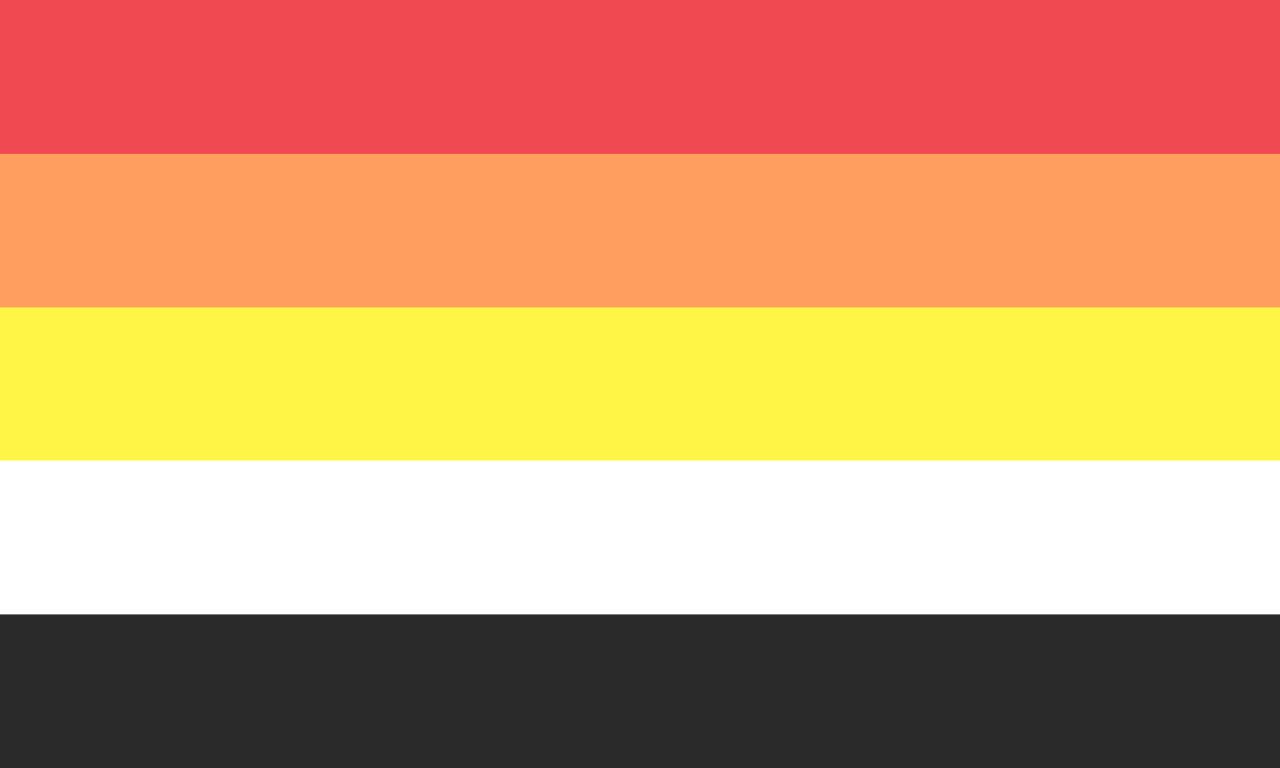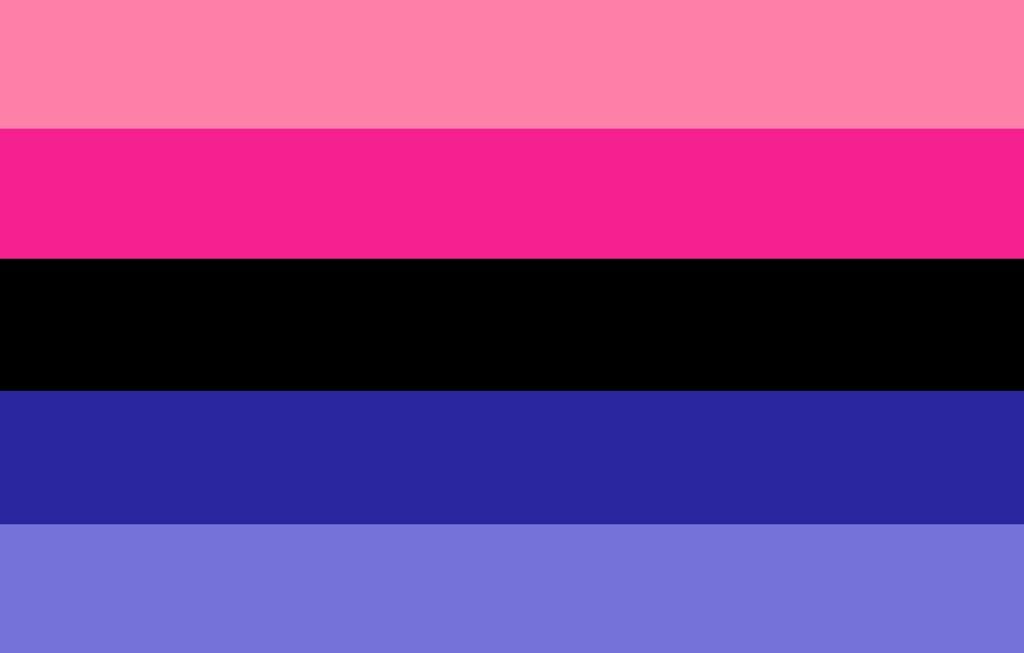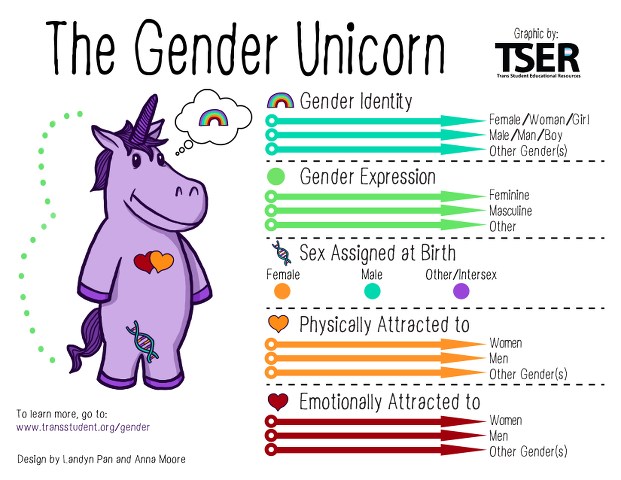Gender & Sexual Diversity
TERMS AND DEFINITIONS
Sexual & Romantic Orientation
+ Akiosexual
Akiosexual (also called akionesexual and lithsexual) refers to a person who experiences sexual attraction, but has their feelings fade if reciprocated. Akiosexual can also be defined as someone who doesn't care or want their feelings reciprocated.

+ Androsexual
Androsexual describes someone who experiences attraction to men and/or masculinity and/or male anatomy, regardless of whether the object of one's affection identifies as a man. The term androsexual can be used by guys, sometimes girls, or most commonly by non binary people. Some androsexual people are only attracted to men, while others are attracted to masculine people no matter their gender. The blue stripe represents men, the brown stripe represents stability and support, and the purple represents attraction to masculinity in general. The earliest use of the term “androsexual” can be traced back to about 1997.

+ Asexual
An asexual is an individual who does not experience sexual attraction, or experiences such a low level of sexual attraction that they do not consider it to be notable.
Asexuality is not celibacy; as people choose who are celibate may experience sexual attraction, but not necessarily act on it.
As all sexualities, diversity among the asexual community means that each individual may experience asexuality differently. Some individuals who identify as Asexual may, or may not masturbate, have sex, create relationships or hold the same definition of Asexuality.

+ Aromantic
An aromantic is a person who experiences little or no romantic attraction to others. People identifying as aromantic can also experience romance in a way otherwise disconnected from normative societal expectations (for example due to feeling repulsed by romance, or being uninterested in romantic relationships.) Where alloromantic people have an emotional need to be with another person in a romantic relationship, aromantics are often satisfied with friendships and other non-romantic relationships. What distinguishes romantic relationships from non-romantic relationships is the romantic intent or lack thereof. This means that the outward expression of a relationship (for example existence of actions such as holding hands, kissing, etc.) can be misleading as to its type. Aromantic people may or may not enjoy activities that are often seen as romantic (e.g. kissing) or be uncomfortable with romance, be single or have a partner or be married - those are individual characteristics that vary between aromantic people.
The aromantic attribute is usually considered to be innate and not a personal choice, just as the lack of sexual attraction is innate to asexuals. It is important to note that aromantic people do not lack emotional/personal connection, but most simply have no instinctual need to develop connections of a romantic nature. Aromantics do not differ from alloromantics in needs of empathetic support, but these needs can be fulfilled in a platonic way.
Most aromantic individuals are involved in, and enjoy, devoted relationships with another person, but these relations are often close friendships, naturally reflecting the closeness of the two individuals and not a purposely initiated monogamous separation as is often found in romantic couples. Aromantic people may also have relationships that go beyond the cultural norms for a friendship and are non-romantic. Sometimes those relationships are called queerplatonic relationships, because they queer (or go against norms of) platonic relationships. Aromantics may experience squishes which are the aromantic or platonic equivalent of a romantic crush.
Like all romantic identities aromantic people can have any sexual orientation.

+ Bisexual
Bisexuality is a broad and inclusive term that describes physical attraction, romantic attraction, or sexual behavior that is not limited to one sex. In the scientific language of sexual orientation, bisexuality encompasses both heterosexual (different sex) and homosexual (same sex) attraction or behavior. In everyday language, depending on the speaker’s culture, background, and politics, that translates into a variety of everyday definitions such as:
- Attraction to men and women
- Attraction to same and other genders
- Attraction to all sexes or genders
- Love beyond gender
Attraction regardless of sex or gender Some important points to note:
- A bi person may be attracted to different sexes or genders in different ways.
- A bi person may be attracted to different sexes or genders more than others.
- A bi person may be attracted to different sexes or genders at some times and not others.
In other words, there are as many ways to be bisexual as there are bi people; just like any other sexuality.

+ Demisexual
Demisexuality is a sexual orientation in which someone feels sexual attraction only to people with whom they have an emotional bond. Most demisexuals feel sexual attraction rarely compared to the general population, and some have little to no interest in sexual activity.

+ Fraysexual
Fraysexual (also known as ignotasexual) is a sexual orientation on the asexual spectrum. It is defined as when someone only experiences sexual attraction towards those that they are not deeply connected with, and lose that attraction as they get to know the person. Fraysexaul is often described as being 'the opposite of demisexual'.
Fraysexual can be a sexual orientation on its own or can combined with other orientations. For example, one could be fraysexual and gay, meaning that when one does experience sexual attraction it's only towards people of the same gender.
The romantic counterpart to fraysexual is frayromantic.
<img data-preserve-html-node="true" src="https://vignette.wikia.nocookie.net/rainbowpedia/images/c/ca/Fraysexual_flag.png/revision/latest/scale-to-width-down/310?cb=20160918182414"alt="Image" width="100">
+ Gay
A man or boy who is emotionally, romantically, sexually, affectionately, or relationally attracted to other men, or who identifies as a member of the gay community. At times, “gay” is used to refer to all people, regardless of sex, who have their primary sexual and or romantic attractions to people of the same sex. Lesbians and bisexuals may feel excluded by the term “gay.”

+ Gynesexual
Gynesexual is a term that describes someone who is attracted to women and/or femininity. Some gynesexual people are only attracted to women, but some are attracted to feminine people no matter their gender. This term can be used by the binary genders, but it’s mostly used by non binary people. For a while people had been saying that the gynesexual label was transphobic because it referred only to being attracted to female body parts, but this is not true. The prefix “gyne” comes from Greek and basically means “women” and since transgender women are women, it’s not transphobic. There is still a lot of misinformation on what this label means, but it’s as simple as being attracted to women and feminine people.

+ Heterosexual
A person who is emotionally, romantically, sexually, affectionately, or relationally attracted to members of the opposite sex. Often called a straight person. Why not call them "straight?"
+ Homosexual
The clinical term, coined in the field of psychology, for people with a same-sex sexual attraction. The word is often associated with the idea that same-sex attractions are a mental disorder, and is therefore offensive to some people.
+ Lesbian
A woman or girl who is emotionally, romantically, sexually, affectionately, or relationally attracted to other women, or someone who identifies as a member of the lesbian community. Bisexual women may or may not feel included by this term.

+ MSM
An abbreviation for men who have sex with men. This term emphasizes the behavior, rather than the identities of the individuals involved.
+ Omnisexual
Omnisexual is very similar to bi, poly, and especially pan, but there is a difference. While pansexual people can experience attraction to people regardless of gender, omnisexual means attraction to all genders. So basically, gender does not play a part for pansexual people, but it does for omnisexuals even though they like all genders. A lot of people use pansexual and omnisexual interchangeably, but they are not the exact same thing. To some people, the distinction might not matter, but to others it does matter and that’s okay. The flag has different shades of blue and pink and purple and black to represent all genders that they are attracted to- men and masculinity, females and femininity, and non binary people and androgyny.

+ Pansexual
A person who is emotionally, romantically, sexually, affectionately, or relationally attracted to people regardless of their gender identity or biological sex. Use of the term usually signals a repudiation of the concept of binary sexes (a concept implied by “bisexual”).

+ Polysexual
A polysexual person is someone who is sexually and/or romantically attracted to multiple genders. It is not the same as being bisexual or pansexual, although all of these sexualities involve being attracted to more than one gender. It also is not the same as being polyamorous.
Polysexuality is often compared to and confused with both bisexuality and pansexuality. To be pansexual is to be attracted to all genders. To be bisexual is, traditionally, to be attracted to two genders, specifically men and women. However, as time has gone on, it has also come to mean to be attracted to people of various genders, beyond binary gender identities.
So how is polysexuality different than bisexuality and pansexuality? A polysexual person is not attracted to all genders. They also do not even have to be attracted to both women and men at all, as traditionally described by bisexuality. For example, a polysexual person might be attracted to women, genderqueer and nonbinary people, but not to men.
A person might appreciate polysexual as a label because it eschews the gender binary traditionally associated with bisexuality, though the meaning has changed. Polysexuality has no such presuppositions. While bisexuality might have its issues because of that, it has the advantage of history and recognition. Ultimately, it is a personal decision to use one label or the other.

+ Queer
Queer is a term that has been reclaimed by members of the GSD community. The term describes people who transgress culturally imposed norms of heterosexuality and gender traditionalism. Although still often an abusive slur, many queer-identified people have taken back the word to use it as a symbol of pride and affirmation of difference and diversity.
+ Questioning
The process of examining one’s sexual orientation and/or gender identity. Can be used as an adjective.
+ Reciprosexual
Reciprosexual or recipsexual is a sexual orientation on the asexual spectrum meaning someone who does not experience sexual attraction unless they know that the other person is sexually attracted to them first. Reciprosexual can be a sexual orientation on it's own or can be combined with other orientations. For example, one could be reciprosexual and gay, meaning that when one does experience sexual attraction it's only towards people of the same gender.
The romantic counterpart of reciprosexual is reciproromantic.

+ Romantic Orientation
Romantic orientation refers to an individual's pattern of romantic attraction based on a person's gender. This is considered distinct from sexual orientation, which refers specifically to a person patterns of sexual attraction, which is distinct from romantic attraction.
- Aromantic: individuals who do not experience romantic attraction toward individuals of any gender(s)
- Biromantic: romantic attraction toward males and females
- Heteroromantic: romantic attraction toward person(s) of a different gender
- Homoromantic: romantic attraction towards person(s) of the same gender
- Panromantic: romantic attraction towards persons of every gender(s)
- Polyromantic: romantic attraction toward multiple, but not all genders
- Gray-romantic: individuals who do not often experience romantic attraction
- Demiromantic: an individual who does not experience romantic attraction until after a close emotional bond has been formed. People who refer to themselves as demiromantic may choose to further specify the gender(s) of those they are attracted to (e.g. demi-homoromantic).
+ Same Gender Loving (SGL)
A term some prefer to use instead of lesbian, gay or bisexual to express attraction to and love of people of the same gender.
+ Sexual Orientation
The nature of an individual's physical, romantic, emotional and/or spiritual attraction to another person. Can involve fantasy, behavior, and self-identification. Includes (among others) a same-sex orientation, male-female orientation, a bisexual orientation, and a pansexual orientation. Gender identity and sexual orientation are not the same. Trans and gender-variant people may identify with any sexual orientation, and their sexual orientation may or may not change before, during or after gender transition.
- Allosexual:Someone who experiences sexual attraction.
- Asexual:An asexual is an individual who does not experience sexual attraction, or experiences such a low level of sexual attraction that they do not consider it to be notable.
- Bisexual:The sexual attraction towards the same gender, and gender(s) different than your own.
- Demisexual: Someone who identifies as Demisexual, does not experience sexual attraction until they form a strong emotional connection with someone.
- Gay:A term that can either be used as an umbrella term for anyone who sexually, or romantically is attracted to someone of the same-sex or same-gender. The second definition is used to exclusively refer to someone who is male-identified, who romantically or sexually is attracted to other male-identified individuals.
- Heterosexuality: This is a sexual attraction to the “opposing” sex/gender. Typically this means a female/women attracted to male/men, and vice versa.
- Omnisexual:An individual who identifies as Omnisexual may have an equal attraction to everyone and/or have no gender preference.
- Pansexual:Pan sexuality is a sexual orientation used to describe an individual who feels they are sexually, and/or romantically attracted to all genders, based on an individual's personality.
- Polysexual:The sexual attraction to numerous, but not every gender/s.
+ WSW
An abbreviation for women who have sex with women. This term emphasizes the behavior, rather than the identities of the individuals involved.
Gender & Sex
+Androgynous
Identifying and/or presenting as neither distinguishably masculine nor feminine.
+ AFAB
Assigned Female At Birth
+ Agender
Someone who does not identify with any sort of gender identity. This term may also be used by someone who intentionally has no recognizable gender presentation. Some people use similar terms such as “genderless” and “gender neutral”.

+ AMAB
Assigned Male At Birth
+ Assigned Sex
The sex/gender one is considered to be at birth based on a cursory examination of external genitalia. Assigned sexes might include male (AMAB), female (AFAB), or intersex.
+ Bi-Gender
Describes individuals who identify as having both a “male” and “female” side to their personalities.A bigender identity is a combination of these two genders, but not necessarily a 50/50 combination, as these genders are often felt – and expressed - fully. Similar to individuals who identify as gender fluid, bigender people may present as men, as women, or as gender-neutral ways on different days.
+ Birth Sex/Biological Sex
A biological term dividing a species into male or female, usually on the basis of sex chromosomes (XX = female, XY = male); hormone levels, secondary sex characteristics, and internal and external genitalia may also be considered criteria. Birth Sex can also be Intersex.
+ Cisgender
A term used to describe a person whose gender identity aligns with those typically associated with the sex assigned to them at birth.
+ Femme
Historically used in the lesbian community, it is being increasingly used by other LGBTQIA people to describe gender expressions that reclaim and disrupt traditional constructs of femininity.
+ FTM
An abbreviation for female-to-male transsexual. This person most likely prefers masculine pronouns.
+ Gender
A binary sociological construct defining the collection of characteristics that are culturally associated with maleness or femaleness; masculine and feminine make up gender just as male and female comprise sex.
+ Genderbread Person / The Gender Unicorn
A commonly used model to explain various aspects of one’s identity, including assigned sex at birth, gender identity, gender expression, physical attraction, and romantic attraction. The Gender Unicorn illustrates how, with the exception of assigned sex at birth, these different aspects of identity exist on spectrums. The Gender Unicorn is available at transstudent.org/gender


The Genderbread person is an infographic that breaks down gender identity, gender expression, biological sex, and sexual orientation in an easy to understand visual.
+ Gender Dysphoria
Clinically significant distress caused when a person's assigned birth gender is not the same as the one with which they identify. According to the American Psychiatric Association's Diagnostic and Statistical Manual of Mental Disorders (DSM), the term - which replaces Gender Identity Disorder - "is intended to better characterize the experiences of affected children, adolescents, and adults."
+ Gender Expression
The external manifestation of one's gender identity, usually expressed through behavior, clothing, haircut, voice or body characteristics.
+ Gender Fluid
Someone whose gender identity and presentation are not confined to only one gender category. Gender fluid people may have dynamic or fluctuating understandings of their gender, moving between categories as feels right. For example, a gender fluid person might feel more like a man one day and more like a woman on another day, or that neither term is a good fit.

+ Gender Identity
One’s innermost concept of self as male, female, a blend of both or neither – how individuals perceive themselves and what they call themselves. One's gender identity can be the same or different from their sex assigned at birth.
+ Gender Modality
Gender Modality refers to the correspondence (or lack thereof) between ones assigned gender at birth and ones actual gender and/or gender presentation.
- Cisgender: When one's assigned gender at birth is the same as one's actual gender.
- Transgender: When one's assigned gender at birth is different from one's actual gender.
- Adgender: When one moves towards a particular gender expression. Includes trans people as well as people who are not trans but still transition.
- Sensgender: When one relates to the trans experience, but only sometimes, temporarily, or not completely.
- Isogender: Someone who is not cis, but does not identify as trans.
- Absgender: Someone beyond, between or removed from trans/cis dichotomy.
- Utrinquegender: Someone who has aspects of both trans and cis experiences.
- Integragender: Someone who has multiple genders and one of them matches their gender assigned at birth, maing them both cis and trans as a result.
- Ipsogender: Intersex people who identify as their assigned gender at birth, but do not feel the term “cisgender” describes them due to being intersex. A “cis intersex” person.
- Ultergender: Intersex people who identify as a gender other than their assigned gender at birth, but do not feel the term “transgender” describes them due to being intersex. A “trans intersex” person.
- Demicisgender: Identifying partially as your assigned gender/sex at birth, and partially not.
- Demitransgender: Identifying partially, but not completely as transgender.
- Cisn’t: An umbrella term for anyone who isn’t cisgender.
Read more here: https://lgbta.wikia.org/wiki/Gender_Modality
+ Gender Non-Conforming
A broad term referring to people who do not behave in a way that conforms to the traditional expectations of their gender, or whose gender expression does not fit neatly into a category.
+ Gender Role
Clothing, characteristics, traits and behaviors culturally associated with masculinity and/or femininity, which varies from culture to culture.
+ Gender Transition
The process by which some people strive to more closely align their internal knowledge of gender with its outward appearance. Some people socially transition, whereby they might begin dressing, using names and pronouns and/or be socially recognized as another gender. Others undergo physical transitions in which they modify their bodies through medical interventions.
+ Gender Variant
A term that describes individuals who stray from socially accepted gender roles.
+ Gender-Expansive
Conveys a wider, more flexible range of gender identity and/or expression than typically associated with the binary gender system.An umbrella term used for individuals who broaden their own culture’s commonly held definitions of gender, including expectations for its expression, identities, roles, and/or other perceived gender norms. Gender expansive individuals include those who identify as transgender, as well as anyone else whose gender in some way is seen to be broadening the surrounding society’s notion of gender.
+ Genderqueer
Describes individuals who possess identities that fall outside of the widely accepted sexual binary.

+ Intersex
Term used for a variety of medical conditions in which a person is born with chromosomes, genitalia, and/or secondary sexual characteristics that are inconsistent with the typical definition of a male or female body. The term disorders of sex development (DSD) also describes these conditions. Replaces the inaccurate term “hermaphrodite.”

+ MTF
An abbreviation for male-to-female transsexual. This person most likely prefers feminine pronouns.
+ Neutrois
An umbrella term within the bigger umbrella terms of transgender or genderqueer. Includes people who do not identify within the binary gender system (i.e., man/woman). According to Neutrois.com, some common Neutrois identities include agender, neither-gender, and gender-less.
+ Nonbinary / Enby
Non-binary (also termed enby, genderqueer or gender-expansive) is a catch-all category for gender identities that are not exclusively masculine or feminine; identities which are thus outside of the gender binary and cisnormativity.

+ Sex Reassignment Surgery (SRS)
A procedure that physically transforms the genitals using plastic surgery. SRS is a single surgical alteration and is only one small part of transition. Not all transgender people choose to, or can afford to, have SRS. While this procedure is often referred to as a sex change operation in popular culture, SRS is the preferred term. An even better term coming into popular use is Gender Confirmation Surgery.
+ Third Gender
A term for those who belong to a category other than masculine or feminine. For example, Native American two-spirit people,hijira in India, kathoeys in Thailand, and travestis in Brazil.
+ Transfeminine
Someone assigned a male sex at birth who identifies as feminine, but may not identify wholly as a woman. Often, you’ll encounter the phrase “feminine of center” to indicate where people who identify as transfeminine see themselves in relation to other genders.
+ Transgender
An umbrella term for people whose gender identity and/or expression is periodically or permanently different from cultural expectations based on the sex they were assigned at birth. In its general sense, it refers to anyone whose behavior or identity falls outside of stereotypical expectations for their gender. Transgender people may identify as straight, gay, bisexual, or some other sexual orientation. Sometimes shortened as trans or trans*.

+ Transmasculine / Transmasc
Someone assigned a female sex at birth and who identifies as masculine, but may not identify wholly as a man. Often, you’ll encounter the phrase “masculine of center” to indicate where people who identify as transmasculine see themselves in relation to other genders.
+ Two-Spirit
Contemporary term chosen to describe Native American and Canadian First Nation people who identify with a third gender, implying a masculine and a feminine spirit in one body. Replaces the offensive term berdache. (Recently, Germany and Nepal adopted a third gender option for citizens to select).
GSD Culture - Oppressions & Triumphs
+ Ally
A person who supports and respects sexual diversity, acts accordingly to challenge homophobic and heterosexist remarks and behaviors, and is willing to explore and understand these forms of bias within him or herself. Often describes a heterosexual individual, but can also be within the community (i.e. a cis gay man who is an ally to trans people, etc.)
+ Biphobia
Fear of, hatred of, or discomfort with people who are bisexual.
+ Cisgender Privilege
The "set of unearned advantages that individuals who identify as the gender they were assigned at birth accrue solely due to having a cisgender identity".
Check out this list of of 30 cisgender privileges
+ Closeted or "In the Closet"
Used as slang for the state of not publicizing one’s sexual identity, keeping it private, living an outwardly heterosexual life while identifying as LGBT, or not being forthcoming about one’s identity. At times, being in the closet also means not wanting to admit one’s sexual identity to oneself.
+ Coming Out
The process by which lesbians, gay men and bisexual people recognize, acknowledge, accept and typically appreciate their sexual identities.

+ DSG
Diverse Genders and Sexualities
+ GSD
Gender and Sexual Diversity (replaces GSM - Gender and Sexual Minorities)
+ Heteronormativity
Processes through which social institutions and policies reinforce the notion that there are only two possibilities for sex, gender, and sexual attraction: male/masculine/attracted to women and female/feminine/attracted to men.
+ Heterosexism
Norms and behaviors that result from the assumption that all people are or should be heterosexual. This system of oppression assumes that heterosexuality is inherently normal and superior and negates GSD peoples’ lives and relationships.
+ Homophobia
Literally, the fear of homosexuals and homosexuality; however, this term is generally applied to anyone who dislikes GSD people, who uses derogatory sexuality- or gender-based terms, or who feels that GSD people want “special rights” and not “equal rights.” Homophobic behavior can range from telling jokes about lesbians and gay men to verbal abuse and even acts of physical violence. Because most GSD people are raised in the same society as heterosexuals, they learn the same beliefs and stereotypes prevalent in the dominant society, leading to a phenomenon known as internalized homophobia.
+ Living openly, Out, or Out of the Closet
A state in which GSD people are comfortably out about their sexual orientation or gender identity – where and when it feels appropriate to them.
+ LGBTQ
LGBTQ is lesbian, gay, bisexual, transgender and queer and/or questioning (sometimes with a “+” at the end in an effort to be more inclusive)
+ Outing
When someone discloses information about another’s sexual orientation or gender identity without that person’s knowledge and/or consent.
+ QUILTBAG
Queer (or Questioning), Undecided, Intersex, Lesbian, Trans, Bisexual, Asexual (or Allied) and Gay (or Genderqueer)
+ Sexism
The societal/cultural, institutional and individual beliefs and practices that privilege men and subordinate and denigrate (trans and cis) women.
+ Sexuality
The complex range of components which make us sexual beings; includes emotional, physical, and sexual aspects, as well as self-identification (including sexual orientation and gender), behavioral preferences and practices, fantasies, and feelings of affection and emotional affinity.

+ To Pass
To represent one’s self as a member of a social group other than one’s own. For example, a lesbian who passes for straight, or a AMAB person who is perceived to be a woman.
+ Trans-friendly
Friendly - Describes organizations or institutions that are open, affirming and accepting of transpeople and their social, political and cultural needs.
+ Transphobia
The Irrational fear of, hatred of, or discomfort with people who are transgender or otherwise gender non-normative.
Important LGBTQ+ dates
+ Holocaust Remembrance Day
January 17 - Official commemoration of the victims of the Nazi regime and to promote Holocaust education throughout the world.
+ Zero Discrimination Day
March 1 - Celebrated by UNAIDS, this day is observed join together against discrimination and inequality in health care, including fighting stigma regarding HIV/AIDS.
+International Transgender Day of Visibility
March 31 - Dedicated to celebrating the accomplishments and victories of transgender & gender non-conforming people while raising awareness of the work that is still needed to save trans lives.
+Lesbian Visibilty Day
April 16 - Celebrates lesbian role models and lesbian life, culture, and diversity
+Day of Silence
April 27 - A student-led national event where folks take a vow of silence to highlight the silencing and erasure of LGBTQ people at school
+International Family Equality Day (IFED)
1st Sunday in May - Celebrates the diversity and equality of LGBT families
+International Day Against Homophobia, Transphobia and Biphobia
May 17 - Created to draw attention to the violence and discrimination experienced by LGBTQ people
+Agender Pride Day
May 19 - Celebrates agender identities
+Harvey Milk Day
May 22 - In memory of Harvey Milk, a gay rights activist and politican in California, assassinated in 1978
+Pansexual and Panromantic Awareness and Visibility Day
May 24 - Promotes visibility and awareness of pansexual and panromantic identities
+Pulse Night of Remembrance
June 12 - Annual day of US remembrance for the loss of 49 people in the Pulse Nightclub shooting in Orlando, Florida on June 12, 2016
+Stonewall Riots Anniversary
June 28 - To remember the 1969 Stonewall Riots at the Stonewall Inn, a catalyst of the LGBTQ movement in the United States
+LGBT Pride Month
June - June is celebrated as Pride Month in honor of the Stonewall Riots.
+International Non-Binary People's Day
July 14 - Annual day celebrating the contributions of non-binary people and focusing on the issues affecting them.
+Bisexual Awareness Week
September - Promotes visibility of bisexuality, and culminates on Celebrate Bisexuality Day
+Celebrate Bisexuality Day
September 23 - elebrates bisexual pride; also called Bi Visibility Day
+International Lesbian Day
October 8 - To celebrate lesbians and lesbian culture around the world
+National Coming Out Day
October 11 - Celebrates coming out as a member of the LGBTQ community, and pushes for environments in which people can safely come out
+International Pronoun Day
October 17 - Seeks to make asking, sharing, and respecting personal pronouns commonplace
+Spirit Day
October 19 -
People wear purple to stand with LGBTQ youth and speak out against LGBTQ bullying
+ International Awareness Day
October 26 - Celebrated in October to commemorate the first intersex protest, which took place in Boston, M
+Asexual Awareness Week
Last week in October - A campaign to educate about different asexual idenities and experiences
+LGBT History Month
October - Celebrates the achievements of great figures and important moments in LGBTQ history
+Transgender Awareness Week
Second week in November - The purpose is to educate about transgender and gender non-conforming people and the issues. It leads up to Transgender Day of Remembrance
+Intersex Day of Remembrance (Intersex Solidarity Day)
November 8 - Observed to highlight issues faced by intersex people; marks the birthday of Herculine Barbin
+Transgender Day of Remembrance
November 20 - Honors the memory of those whose lives were lost in acts of anti-transgender violence
+World AIDS Day
December 1 - Recognized by the UN, this day is an opportunity for people worldwide to unite in the fight against HIV/AIDS
+Pansexual Pride Day
December 8 - Dedicated to celebrating pansexuality
+Human Rights Day
December 10 - Commemorates the day in 1948 the United Nations General Assembly adopted the Universal Declaration of Human Rights



